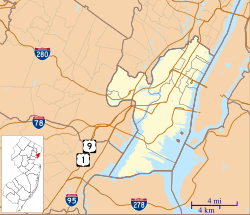Jersey City YMCA | |
 | |
| Location | 654 Bergen Avenue, Jersey City, New Jersey |
|---|---|
| Coordinates | 40°43′17″N74°4′19″W / 40.72139°N 74.07194°W |
| Area | 3 acres (1.2 ha) |
| Built | 1924 |
| Architect | John F. Jackson |
| Architectural style | Classical Revival, Renaissance |
| NRHP reference No. | 99001314 [1] |
| NJRHP No. | 129 [2] |
| Significant dates | |
| Added to NRHP | November 12, 1999 |
| Designated NJRHP | September 29, 1999 |
The Jersey City YMCA, is located in Bergen Section of Jersey City, Hudson County, New Jersey, United States. The YMCA building was added to the National Register of Historic Places on November 12, 1999. The building is an example of an early twentieth century Renaissance Revival style. [3] Built in 1923, [4] in 1995 the building ceased to be used by the YMCA and was converted into affordable housing. [5]


